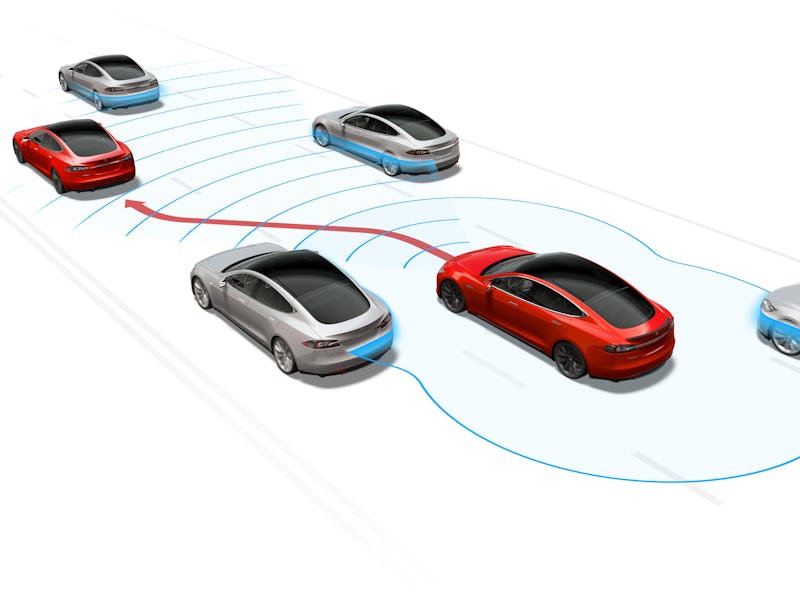Tesla Autopilot just reached a huge halfway point toward full self-driving
The company's semi-autonomous driving system has crossed a key threshold in the road to full autonomy.

Tesla has crossed a key milestone in its goal toward offering fully autonomous driving.
In a presentation video released this week, the company announced its cars had completed three billion miles of driving in the semi-autonomous Autopilot mode. This mode allows the car to complete certain maneuvers like driving along a highway while requiring human oversight at all times, and is expected to gradually develop into a fully-autonomous system.
It's a big step forward for Tesla, and one that draws the firm closer to CEO Elon Musk's ultimate goal for Autopilot. The company plans to eventually support point-to-point autonomous driving with no need for human oversight. That will require government approval, and Musk has previously estimated this could come after six billion miles.
This halfway point has been years in the making. In the company's second master plan unveiled in July 2016, Musk explained how developing the software is just one step toward full autonomy:
Even once the software is highly refined and far better than the average human driver, there will still be a significant time gap, varying widely by jurisdiction, before true self-driving is approved by regulators. We expect that worldwide regulatory approval will require something on the order of 6 billion miles (10 billion km). Current fleet learning is happening at just over 3 million miles (5 million km) per day.
With this new milestone, Tesla appears to have reached the halfway mark in Musk's suggested road to full autonomy.
The presentation was hosted by Andrej Karpathy, Tesla's head of artificial intelligence, at the Scaled Machine Learning Conference on February 26 and 27 at the Computer History Museum in California, a 15-minute drive from Tesla's headquarters. A video of the presentation was uploaded on April 20, and Electrek spotted the video on Wednesday.
"We've now accumulated almost three billion miles on the Autopilot, which sounds like a lot," Karpathy said, accompanies by a presentation slide that confirmed the figure. The figure includes one billion miles with Navigate on Autopilot, a feature that exits the highway at the correct moment based on inputted destination. That feature has completed 200,000 automated lane changes. Karpathy's number also includes 1.2 million Smart Summon sessions, a feature that brings a car out from a parking spot and meets the driver.
The three billion mile figure.
Tesla Autopilot has gradually improved since it first enabled the feature in October 2015. Early versions, known as "Hardware 1," used a system designed by MobilEye. By April 2016, Tesla vehicles had driven 44 million miles in Autopilot mode.
In October 2016, Musk announced Tesla vehicles had driven three billion miles, 222 million of which were Autopilot-enabled. That same month, the firm announced it was switching to an in-house system of cameras and sensors dubbed "Hardware 2." This system, included with every Tesla from that date, is designed to one day support fully autonomous driving.
By November 2018, Autopilot had accumulated one billion miles, around 10 percent of all miles driven by Tesla vehicles. In November 2019, MIT researcher Lex Fridman estimated the fleet had accumulated two billion miles but this was not confirmed by Tesla.
Tesla has gradually taken steps toward fulfilling its full autonomy goals. It unveiled a new computer in August 2018, "Hardware 3," designed for use with "Hardware 2" vehicles to offer faster processing. It's rolled out new features for Autopilot like Navigate on Autopilot, which turns the car off the highway at the correct exit.
The Inverse analysis
Tesla's milestone demonstrates the success of the Autopilot program, as it collects vital data for training its systems on how to drive.
Waymo, an autonomous car developer that operates a service in Arizona, also makes a habit of regularly announcing its amount of total miles. In January 2020 it announced that it has driven 20 million autonomous miles on public roads and tens of billions of miles on simulated roads. Just like with Tesla, all this data is helping to train its systems how to drive a car.
But regulatory approval may not be quite so straightforward. Musk acknowledged as much this month, when he said the company's planned autonomous taxi service could be ready this year from a functionality standpoint. Regulatory approval, which would actually allow the cars to operate as autonomous taxis, is what Musk referred to as “the big unknown.” Six billion might not be enough.